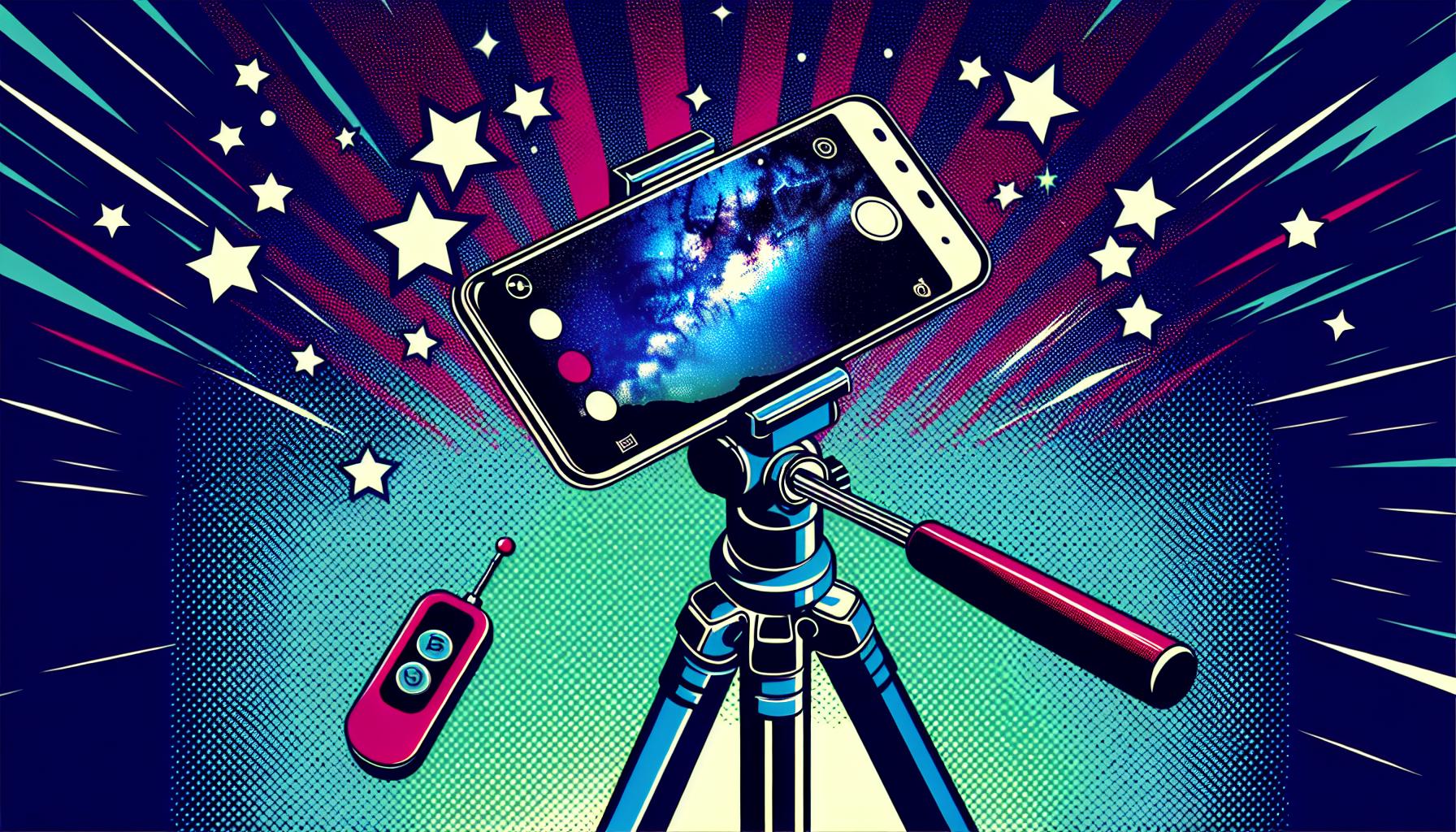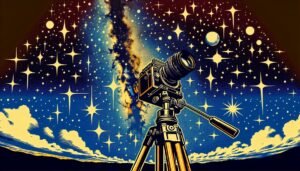This site contains affiliate links to products. I may receive a commission for purchases made through these links.
Ever looked up at the night sky and wished you could capture its breathtaking beauty with your iPhone? Well, you’re not alone. I’ve been there, and I’ve learned that it’s not only possible, but it’s also quite easy to photograph stars with an iPhone.
Choosing the right location
If there’s one thing I’d underscore, it’s Choosing the Right Location. This is a vital part of your star photography expedition. To get the best shot, remember these key factors:
- Light pollution
- Weather conditions
- Open skyline
Light pollution plays a significant role in the visibility of stars. It’s simply impossible to get a good shot of stars with excessive light around. The darker the surroundings, the brighter the stars will appear, yielding better quality photos. My tip? Reach out to the countryside, away from city lights. There are even light pollution maps readily available online, to find the least polluted areas near you.
Next, focus on weather conditions. An overcast sky can effectively ruin star photography. Check weather forecasts to ensure that the night you plan to shoot has clear skies. Remember, crisp air after a bout of rainfall can intensify the clarity of your photographs.
Lastly, the skyline should be wide and open. A panoramic view of the night sky without any obstructions, such as tall buildings or trees, will ensure you can capture as many stars as possible in your frame.
When I ventured into star photography with my iPhone, I found National Parks to offer some of the best locations. Most parks have secluded areas with minimal light pollution. Plus, their expansive landscapes provide an unobstructed view of the sky. To top it off, parks have stunning natural landscapes to add depth and context to your starry photographs.
Additionally, I’ve found some less obvious locations that work surprisingly well like rooftops and nearby open fields. With just a bit of creativity, you can snag fantastic shots from unexpected places.
So, get your iPhone ready, scout for the right place, and prepare to capture the captivating beauty of a star-filled sky.
Preparing your iPhone for night photography
Although scouting the right location for a clear night sky is one crucial factor, it’s equally important that your iPhone is in the best condition for capturing those breathtaking stellar images. Here’s how I prepare my iPhone for night photography:
Adjust the Settings: To start, I modify my iPhone’s settings to ensure optimal performance. I switch to Airplane Mode to prevent unwanted interruptions from calls or messages during a shoot. I also turn down the brightness to save battery.
Choose the Right Mode: After adjusting the settings, it’s time to select the appropriate mode. I usually use the Night Mode on newer iPhone models as this setting is designed for low-light photography. If your iPhone doesn’t have Night Mode, don’t worry. Apps like ProCamera, NightCap Pro and others can significantly improve your night photography skills.
Exposure Settings: You’ll find this option in the top-right corner, symbolized by a half-filled circle. After tapping on it, swipe downwards to reduce exposure. Why do we want to do this? In a nutshell, a lower exposure permits less light into your camera lens. It’s this reduction that helps deliver well-defined, clear shots of the night’s sky.
Focus on Stability: Stability plays a vital role in capturing clear shots of the night sky. I always use a tripod, though leaning your phone on a stable surface can also improve image sharpness.
Use Manual Focus: Most of the time, auto-focus doesn’t work ideally under low light conditions. It’s always better to manually adjust the focus to infinity (if your chosen app allows for it). This ensures that stars appear as sharp points of light in your images.
Don’t forget to check that your iPhone’s lens is clean and free from smudges. Tiny imperfections can lower your photos’ quality without you even realizing it.
Lastly, practice is key. Night photography can be tough, especially if you’re new to it. Experiment with different settings and don’t be afraid to make mistakes. Every shot you take brings you one step closer to capturing that perfect photo of the stars.
Using a tripod for stability
To elevate the quality of your night sky photography, using a tripod is indispensable. It stabilizes your iPhone, ensuring sharp, clear photos by eliminating the blur that can result from shaky hands. I can’t stress enough how vital it is to have a sturdy platform, especially for long-exposure shots like star photos.
When it comes to tripods, there’s a range of options to suit your budget and needs. Explore tripods designed specifically for iPhone that often come with a phone mount included. Ensure the tripod’s sturdiness; it needs to stand firm against wind and other outdoor elements.
Don’t forget that iPhone has a threaded hole for attaching it to tripods, but you’ll most likely need an adaptor. You’ll need to invest in a good quality tripod mount or an phone-case with tripod connection to affix your iPhone to the tripod.
Beyond that, configuring your tripod for night photography isn’t very different from daytime settings. You’ll want to adjust its height and angle to suit the composition of your shot. It might take a moment to get the right positioning, so be patient and keep dabbling until the stars align – pun intended.
Moreover, have a look at various photography apps available on the App Store that offer self-timer features. This handy feature lets you trigger the shutter with a delay, ensuring you won’t move the iPhone and disrupt the shot when you press the shutter button.
Capturing and editing stellar photos
Finally, with a sturdy tripod in place and ideal settings dialed on your iPhone, you’re now set to capture the cosmic splendor above.
Using a self-timer or remote control helps to further reduce unnecessary vibrations. Once you tap the shutter button, it’s time now to patiently wait for the exposure to complete. The waiting times vary greatly, depending on factors such as your chosen ISO, exposure time, and brightness of the sky. Try not to rush through this crucial phase. Remember, patience is a virtue in night sky photography.
Personally, I’ve found it pleasing to experiment with different compositions while waiting. Try positioning the starry sky in various parts of the frame, like the center, corners, or even at an angle. With each shot, you’re not just chasing the perfect photo, you’re learning more, developing a keen eye for composition.
But capturing the photo is just half the battle. Editing is where the real magic happens. I recommend using apps like Snapseed, Lightroom or even iPhone’s built-in editing tools for this purpose. Correct adjustment of highlights, shadows, contrast, and saturation can make a stark difference in bringing out the details in your star photography.
To get started, adjust the brightness and contrast to reveal the hidden stars. Next, play with the saturation and temperature values to achieve the desired hue. Remember, overdoing these adjustments can result in artificial-looking images. The goal should be to retain a natural and authentic feel.
Here’s a simple cheat sheet to consider while editing:
| Aspect | Adjustment |
|---|---|
| Brightness | Increase gently to reveal hidden stars |
| Contrast | Use sparingly to create deeper blacks |
| Saturation | Alter to achieve desired hues |
| Temperature | Adjust for a warm or cool tone |
Admittedly, phone-based editing can be quite limited, especially when it comes to increasing the clarity of stars. If you’re looking to take your edits to another level, consider investing in software like Photoshop or Lightroom CC which offer advanced features designed for astrophotography.
Conclusion
So there you have it. With a sturdy tripod and a few clever apps, your iPhone is fully equipped to capture the night sky’s awe-inspiring beauty. Remember, it’s all about stability, patience, and the right editing tools. Don’t be afraid to experiment with your shots and adjust as needed.
Use Snapseed, Lightroom, or your iPhone’s built-in tools to bring out those stellar details. Keep honing your skills, and you’ll soon master the art of iPhone star photography. Now, it’s time to get out there and start shooting!
Don’t forget to subscribe to our newsletter where you’ll find the latest cosmic discoveries, expert stargazing tips, and exclusive subscriber deals. Embark on your cosmic journey if you haven’t already!
Frequently Asked Questions
Why is a tripod essential in night sky photography?
A tripod provides stability, essential for eliminating blur and ensuring sharp, clear photos, especially in long-exposure shots such as star photos. It helps to correctly position your iPhone for the perfect shot.
How do I attach my iPhone to the tripod?
The iPhone can be attached to the tripod using a tripod mount or a phone case with a tripod connection. These tools allow secure affixing of the iPhone to the tripod for stability.
How do I adjust the tripod for the perfect shot?
Adjust the tripod’s height and angle to suit the composition of the shot. Many tripods allow adjustments to ensure optimal positioning for your photo.
Why should I consider using a self-timer or remote control for night sky photography?
Using a self-timer or remote control helps reduce vibrations caused by manual shutter release. This ensures clearer, sharper images in your night sky photography.
What are some recommended editing apps for star photography?
Recommended image-editing apps include iPhone’s built-in tools, Snapseed, and Lightroom. They allow enhancement and detail refinement in your star photos. For more advanced features, consider investing in software like Photoshop or Lightroom CC.
You may also like:



